Japanese Flowering Cherries, Prunus pendula, Prunus sargentii, Prunus serrulata, Prunus x yedoensis, Prunus x subhirtella
The cherry blossom (sakura) is Japan’s unofficial national flower. Celebrated for centuries, it is esteemed as the most beautiful and important of flowers in Japanese culture. In spring, during the blossom-viewing season called Hanami, cherry blossoms are celebrated with huge festivals, parties, and family picnics wherever the cherries grow.
The term “cherry blossom” refers to seven species of Prunus (Prunus campanulata, P. incisa, P. jamasakura, P. serrulata, P. sargentii, P. spachiana (syn. subhirtella), and P. speciosa) and their cultivars. According to the Flower Association of Japan, there are over three hundred species, varieties, and hybrids of Japanese cherry blossoms. These flowering cherries come in various sizes and shapes, and several are excellent additions to the garden. All are incredibly beautiful.
Several characteristics differentiate the many cherry tree varieties. Some of the obvious ones which are of particular interest to gardeners are listed below.
Cherry blossoms have from 5 to more than 300 petals (!) They can be divided into four groups based on the number of their petals. Single flowers feature five petals and sometimes 1-3 extra petals. Semi-double flowers boast 10-20 petals, while double flowers exhibit 25-50 petals. The impressive chrysanthemum flowers are packed with over 100 petals. In Japan, many people consider these double or chrysanthemum flowers quite gaudy. Their most popular and acclaimed cherry blossom is the Yoshino (Prunus x yedoensis), which has five white petals and is treasured for its delicate, simple form.
The same cultivar may display single flowers with five petals on one specimen but 15 petals per flower on another specimen. Soil fertility may impact these variations as fewer petals tend to be produced in lean soils.
The petals may be oval, egg-shaped, or round. They may be wrinkled, frilled, or display wavy margins.
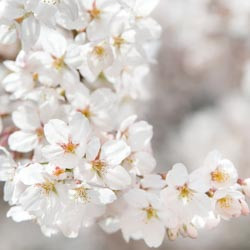
|
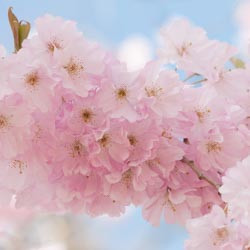
|
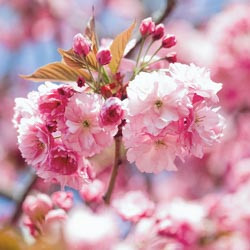
|
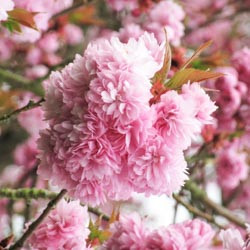
|
Most cherry flowers are light pink to white, but there are also cherry trees with dark pink, yellow, or green blossoms. However, appreciating the color of these lovely blooms is not always easy because cherry blossoms change color over time. Many are dark pink when in the bud, lighter pink when blossoming, and then pale pink or white when fully open. Some cherries, such as ‘Shirofugen‘, see their whole flower color change from white to pink, giving an entirely new look at the end of the flowering season.
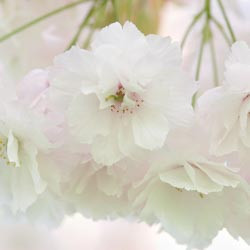 White blossoms White blossomsPrunus ‘Shogetsu’ |
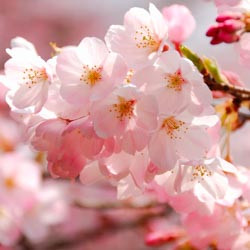 Soft Pink blossoms Soft Pink blossomsPrunus x yedoensis ‘Akebono’ |
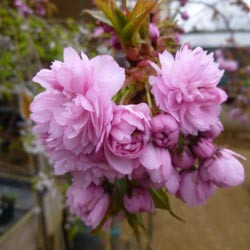 Deep Pink blossoms Deep Pink blossomsPrunus ‘Kiku-shidare-zakura’ |
Many Japanese flowering cherries are fragrant and exude a pleasing scent of crushed almonds. Prunus ‘Amanogawa‘ is reported by some as having a freesia fragrance. However, on cold and rainy days, their fragrance is barely perceptible, except for strongly scented cherries such as ‘Amanogawa‘ or ‘Jo-nioi’. The Japanese word ‘nioi’ means fragrance and is often added to the cultivar name.
Most cherry tree varieties bloom in spring over a season that usually lasts several weeks. However, changes in weather conditions may impact the flowering time, advancing or delaying the appearance of the beloved cherry blossoms by several weeks. Generally, the milder the climate, the earlier the blossoms open.
Spring as a season can be short and last only three weeks, as in Japan. Spring may last six weeks or even more in areas with moderate climates, such as Britain or the Netherlands.
The cherry blossom season is relatively short. There may be 2 or 3 weeks between the opening of the first blossom and the shedding of the petals. Generally, the double flowers last longer than the single ones. Strong wind and rain can make the blooming season even shorter.
Not all cherry trees bloom at the same time. There are early bloomers such as Prunus pendula ‘Pendula Rosea‘ and Prunus x yedoensis (Yoshino cherry). They are followed by garden cherries, including the lovely Prunus ‘Accolade’, the deep pink Prunus pendula ‘Pendula Rosea’, and pure white Prunus ‘Umineko‘. Closing the spring season is the incredibly popular Prunus ‘Kanzan’ or Prunus ‘Shogetsu’.
Some Cherry tree varieties enjoy a particularly long blooming season and flower in flushes in the fall and during the winter months. Among them are Prunus subhirtella ‘Autumnalis Rosea’ (Rosebud Cherry) and Prunus subhirtella ‘Autumnalis’.
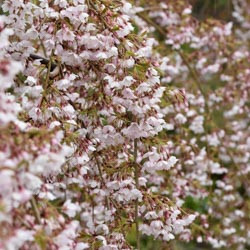
Early Blooming Flowering Cherry |
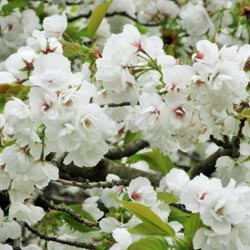
Mid-Season Flowering Cherry |
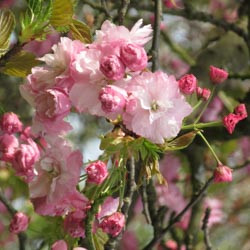
Late Blooming Flowering Cherry |
Although ornamental cherry trees are typically planted for the majestic yet delicate beauty of their flowers, many varieties are noted for their lovely foliage and multi-season interest. Some display wonderful fall colors, with their foliage turning brilliant shades of gold, red, or orange.
Usually, the foliage unfolds in the spring, before the flowers, at the same time, or after the blossoms open. In the case of early blooming cherry varieties, the new leaves appear only after the blossoms wane, which creates a spectacular look with thousands of showy pink-white blossoms smothering the bare branches – a sight to behold. In the case of later-blooming cherry varieties, the leaves usually appear before the blossoms, giving the trees a different look.
The color of the new leaves differs between cherry varieties. In most cases, the fresh leaves are green with a bronze hue. They generally mature to dark green and create a lovely summer canopy. Some cherry varieties display wonderful fall color, with their foliage turning brilliant shades of gold, red, or orange before shedding to the ground.
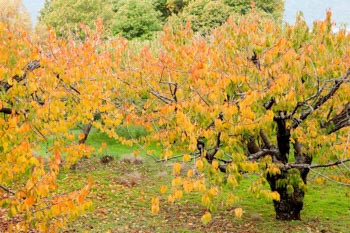 |
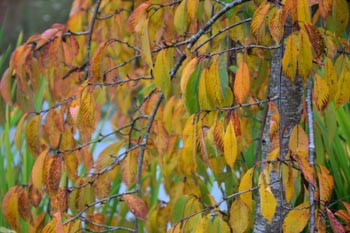 |
Japanese flowering cherries enjoy graceful shapes that command attention and create beautiful features in winter. There are 5 types of tree shapes and habits:
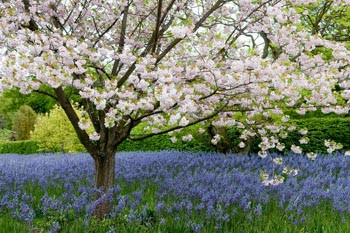
Funnel shape becoming very broad |
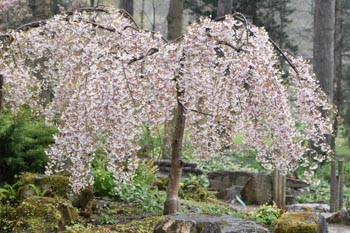
Weeping Shape |
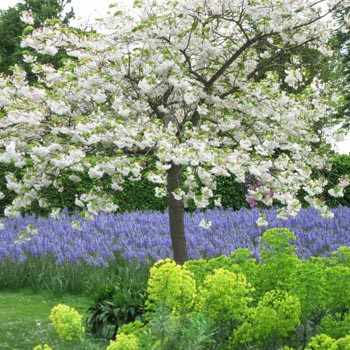
Umbrella shape with a broad and flattened crown |
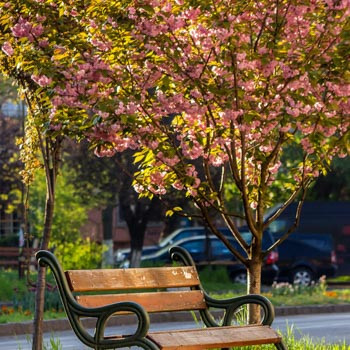
Fastigiate shape |
Cherry Blossom trees do well in most gardens, and their care requirements are minimal. There are a few things to bear in mind, though, before purchasing a flowering cherry tree:
Location: Choose a location with full sun to partial shade. They require at least 6 hours of sunlight daily to produce the best bloom and growth. Therefore it is important to plant your tree in a spot that is not too shady or crowded.
Soil: These trees prefer relatively fertile, well-drained soil with a slightly acidic pH. Amend heavy clay or sandy soils with compost or other organic matter to improve fertility and drainage.
Planting: Dig a hole twice as wide and just as deep as the root ball. Place the tree in the hole, ensuring the top of the root ball is level with the soil surface. Backfill with soil and firm gently. Ensure the mature height and spread of the tree you wish to purchase will fit your intended area. The best time to plant is in early spring, after the danger of frost has passed, or in early fall, allowing plenty of time for roots to establish before the first freeze.
Watering: Water deeply and thoroughly after planting. Afterward, maintain consistent moisture, particularly in dry periods, but be careful not to overwater.
Mulching: Apply a layer of mulch around the tree after planting.
Pruning: Flowering cherries grow best if left alone, so it is best to avoid pruning aside from removing dead, diseased, or damaged growth. If you need to shape your tree, do so after flowering in early summer because there are fewer diseases, and you won’t remove the flower buds.
Fertilizing: Apply a balanced slow-release fertilizer in early spring, before the onset of new growth.
Winter Care: In colder regions, consider wrapping young trees or applying a layer of mulch around the base to protect from frost.
While known for their beauty, Cherry Blossom trees are not immune to pests and diseases. Here are a few common issues you might encounter:
Pests
Diseases
Prevention is key in managing these potential problems. Regular monitoring, maintaining good tree health, and practicing proper sanitation (like cleaning up fallen leaves and pruning out diseased branches) can go a long way in preventing outbreaks.
| Plant Type | Trees |
|---|---|
| Genus | Prunus - Flowering Cherry Tree |
| Exposure | Full Sun |
| Season of Interest |
Spring (Early, Mid, Late) Fall Winter |
| Maintenance | Low |
| Water Needs | Average |
| Soil Type | Chalk, Clay, Loam, Sand |
| Soil pH | Acid, Alkaline, Neutral |
| Soil Drainage | Moist but Well-Drained, Well-Drained |
| Characteristics | Fragrant, Plant of Merit, Showy |
| Attracts | Birds, Butterflies |
| Landscaping Ideas | Beds And Borders |
| Garden Styles | City and Courtyard, Informal and Cottage, Japanese Garden, Traditional Garden |
daizuoxin / 123RF Stock Photo
| Plant Type | Trees |
|---|---|
| Genus | Prunus - Flowering Cherry Tree |
| Exposure | Full Sun |
| Season of Interest |
Spring (Early, Mid, Late) Fall Winter |
| Maintenance | Low |
| Water Needs | Average |
| Soil Type | Chalk, Clay, Loam, Sand |
| Soil pH | Acid, Alkaline, Neutral |
| Soil Drainage | Moist but Well-Drained, Well-Drained |
| Characteristics | Fragrant, Plant of Merit, Showy |
| Attracts | Birds, Butterflies |
| Landscaping Ideas | Beds And Borders |
| Garden Styles | City and Courtyard, Informal and Cottage, Japanese Garden, Traditional Garden |
Create a membership account to save your garden designs and to view them on any device.
Becoming a contributing member of Gardenia is easy and can be done in just a few minutes. If you provide us with your name, email address and the payment of a modest $25 annual membership fee, you will become a full member, enabling you to design and save up to 25 of your garden design ideas.
Join now and start creating your dream garden!
Create a membership account to save your garden designs and to view them on any device.
Becoming a contributing member of Gardenia is easy and can be done in just a few minutes. If you provide us with your name, email address and the payment of a modest $25 annual membership fee, you will become a full member, enabling you to design and save up to 25 of your garden design ideas.
Join now and start creating your dream garden!